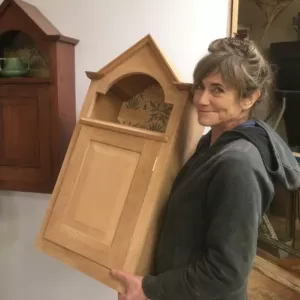Still Remembering a Contemporary Craftswoman for the Ages
by Kate Nixon
I know we are past Women’s History Month, but I’m still thinking about Nancy Hiller.
Being the director of the National Arts and Crafts Conference and Shows means a number of things. Among the many victories, challenges, and logistics of this position, one element that fills my heart reigns above all others. I get to meet and develop relationships with the best Antiques dealers, the most talented artists and craftspeople in the country, and witness the fight of historical sites and organizations of both maintaining and educating about their own legacies. I am also humbled to know those in our community who made history, including the late and great Nancy Hiller. In the short time that I knew and briefly worked with her, I knew she was accomplished, but I had no idea what ceilings she punched through and when her obituary made The New York Times in 2022, I read it in amazement over and over again.
While there are countless examples of historic and contemporary women in this movement worthy of celebrating, I’ve had a quote taped to my desk from Hiller that I’ve glanced at every day. It’s like she’s speaking from the great beyond. Her words are still relevant to those who seek to not only continue a craftsman legacy, but to take on the heavy responsibilities of owning a small business and attempting to keep their sanity in the modern world.
“Doing what you love for a living demands that you cultivate a larger understanding of loving what you do—one that will accommodate the headaches, stress, sporadic income, difficult clients, occasional doldrums, and sleepless nights that can come with being self-employed. When you think about it, this is no different from the deeply committed love that grounds a long marriage, which may involve stretches of monotony, moments of doubt, tending to a sick spouse (or parent, or child) and the occasional hour or (let’s be honest) more of utter exasperation. “ – Nancy Hiller
When I knew her, she was gracious, hard working and straight to the point. She asked thoughtful questions and many of them since she wanted to come to the shows prepared. Not that I – a green young ‘un to the world of “capital A and capital C” Arts & Crafts – felt qualified to answer some of her worries, but from what I saw of her works, I knew she would attract the right people.
Read The New York Times obituary on Nancy Hiller written by Clay Risen: “Nancy Hiller, Who Broke a Glass Ceiling in Woodworking, Dies at 63”
Read the “About the Author” Interview with publisher Lost Art Press: “About the Author: Nancy Hiller”
I was a few years into my job as a registration manager at our beloved conference at the Grove Park Inn, when I first met Nancy face to face. She had a few questions for me. Out of all the things I remember about Nancy Hiller the person, I remembered that she literally leaned in to talk about her booth and a couple of normal concerns that someone new to the shows would ask. It is slightly nervewracking, directing a woodworking powerhouse on what to do and where to go. Nancy however was earnest and knew what she wanted, so even in the brevity of our conversations, I could tell she was more than worthy and qualified to be in any artisan woodworking show she set her eyes on.
She not only set her sights on the era of English Arts & Crafts furniture to emulate, she lived the head, hearts, and hand lifestyle and took on the massive job of a one-woman workshop, NR Hiller Design. She was an author, publishing a few books on English Arts & Crafts furniture, Interior Design, and historic preservation. Her list of clients were from all over the country as her influence as a cabinetmaker spread quickly. But before all of that, in the late seventies, she made her own furniture for her apartment in attempt to save some money. Her journey of a maker had just begun.
Nancy Hiller may have been a maker, author, supporter of the Arts & Crafts movement, and teacher, but aside from her accomplishments, she was honest and straightforward. In the magazine Fine Woodworking, she was quick to remove any romanticism of the woodworker identity and reveal the truth about being a craftsman. “Grappling with this work in the most existential ways has not resulted in me losing my passion, but in learning what a deeper form of passion entails.”
That kind of honesty needs to be felt by anyone who, despite the hardships of this world, moves forward with eyes open.


